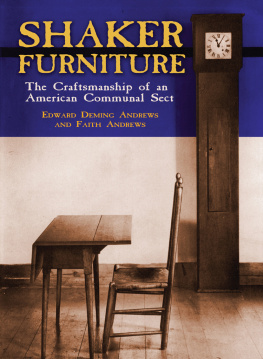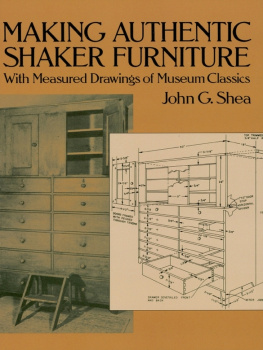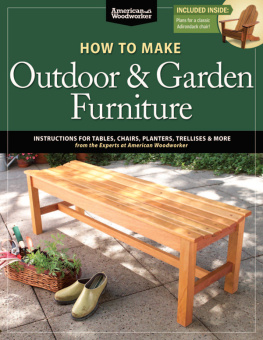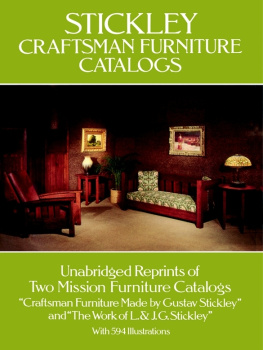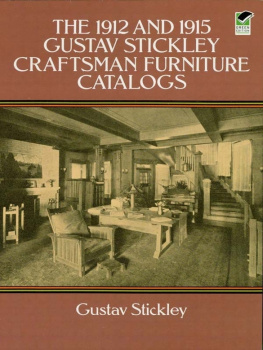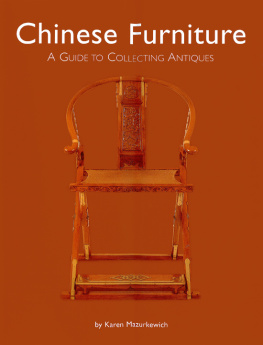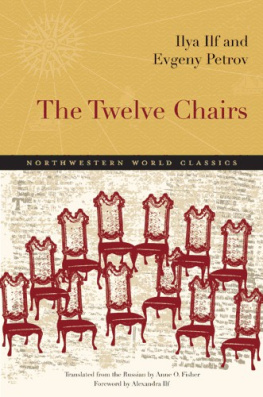Edward D. and Faith Andrews - Shaker Furniture
Here you can read online Edward D. and Faith Andrews - Shaker Furniture full text of the book (entire story) in english for free. Download pdf and epub, get meaning, cover and reviews about this ebook. year: 2014, publisher: Dover Publications, genre: Religion. Description of the work, (preface) as well as reviews are available. Best literature library LitArk.com created for fans of good reading and offers a wide selection of genres:
Romance novel
Science fiction
Adventure
Detective
Science
History
Home and family
Prose
Art
Politics
Computer
Non-fiction
Religion
Business
Children
Humor
Choose a favorite category and find really read worthwhile books. Enjoy immersion in the world of imagination, feel the emotions of the characters or learn something new for yourself, make an fascinating discovery.
- Book:Shaker Furniture
- Author:
- Publisher:Dover Publications
- Genre:
- Year:2014
- Rating:5 / 5
- Favourites:Add to favourites
- Your mark:
- 100
- 1
- 2
- 3
- 4
- 5
Shaker Furniture: summary, description and annotation
We offer to read an annotation, description, summary or preface (depends on what the author of the book "Shaker Furniture" wrote himself). If you haven't found the necessary information about the book — write in the comments, we will try to find it.
48 sharp photos show side chairs, long benches, rocking chairs, chests, cupboards, much more. Exact measurements given for each piece to aid in identification, reconstruction, restoration. Alsohighly readable commentary on sects cultural background.
Shaker Furniture — read online for free the complete book (whole text) full work
Below is the text of the book, divided by pages. System saving the place of the last page read, allows you to conveniently read the book "Shaker Furniture" online for free, without having to search again every time where you left off. Put a bookmark, and you can go to the page where you finished reading at any time.
Font size:
Interval:
Bookmark:
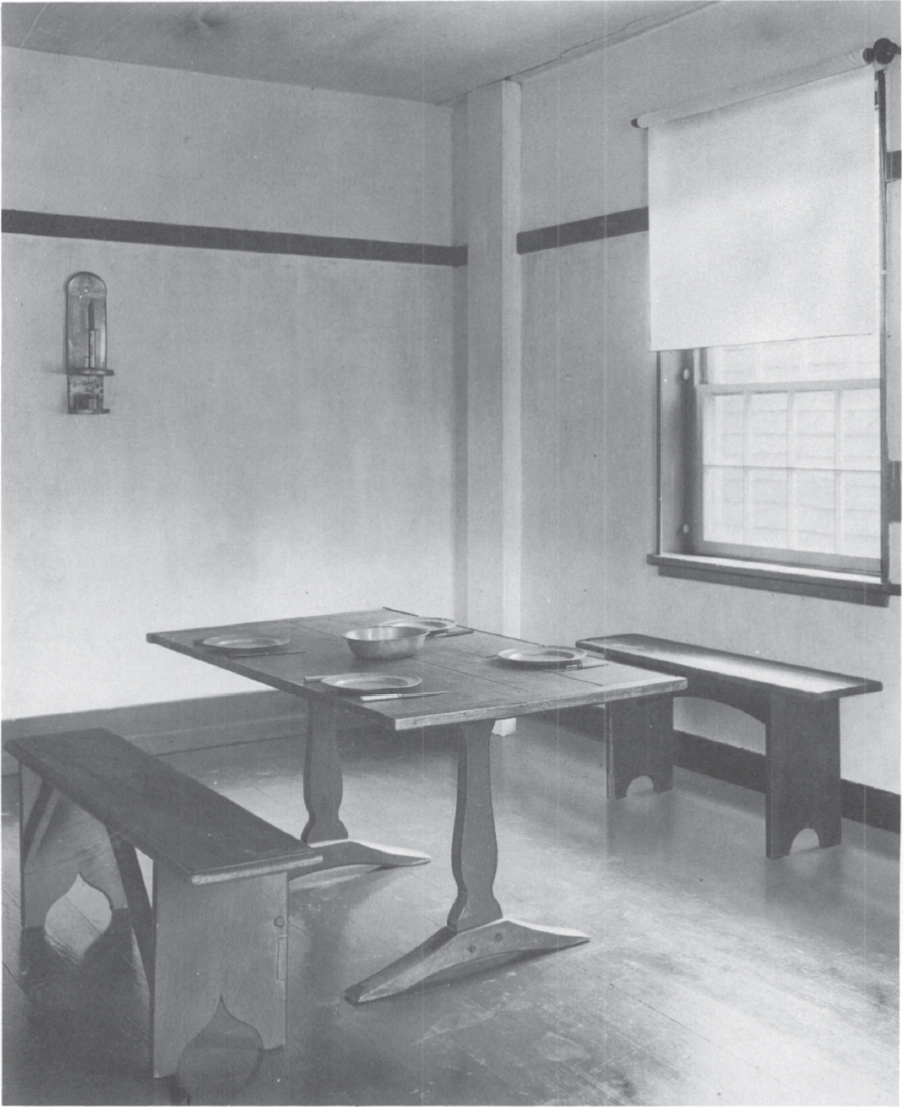
FURNITURE

THE CRAFTSMANSHIP
OF AN
AMERICAN COMMUNAL SECT

BY
EDWARD DEMING ANDREWS
AND
FAITH ANDREWS
PHOTOGRAPHS BY WILLIAM F. WINTER
DOVER PUBLICATIONS, INC. NEW YORK
Copyright 1937, 1964 by Edward Deming Andrews and Faith Andrews.
All rights reserved.
This Dover edition is an unabridged republication of the work originally published by the Yale University Press in 1937. The original publication of this work was assisted by a grant from the American Council of Learned Societies.
Standard Book Number: 486-20679-3
Library of Congress Catalog Card Number: 50-7797
Manufactured in the United States by Courier Corporation 20679302
www.doverpublications.com
eISBN-13 978-0-486-20679-0
(Following page 66)
. Ministrys dining room, with early trestle table and benches. frontispiece
. Long communal dining table with benches.
. Community dining table and early dining chairs.
. Side chairs arranged for a union meeting.
. Long meeting-house benches.
. Ironing-room, with table and chairs.
. Ministry sisters room. Stretcher-base table, rocking chairs and mirror.
. Sisters gathering or common room. Drop-leaf tables, chairs and stove.
. Maine Shaker craftsmanship. Tables and chair.
. Kitchen table and bench.
. Shaker bake-room furnishings.
. Early Shaker stands.
. Round stand, with side chairs.
. Workstand, with brethrens rocker and pipe-rack.
. Sewing stands and chairs.
. Round stand, with early rocking chairs and clock.
. Four-legged sewing stand or table. Small built-in pine cupboard with drawers.
. Chests and chairs for children.
. Blanket- or storage chests.
. Small case of drawers and drop-leaf table.
. Wood-box and washstand.
. High cupboard-chest and step-stool.
. High pine case with base cupboard.
. Weave-chest or sill cupboard, with accessories.
. Cellar cupboard and bench.
. Built-in drawers and cupboards.
. Built-in cupboards and drawers in brethrens retiring-room.
. Sideboard used by Canterbury ministry.
. Long tailoring counter.
. Tailoresses shop. Counter, chairs and looking glass.
. Sewing stands, with swivel-stools.
. Large sewing desk.
. Sewing cabinets or tables from Hancock.
. Furniture unit in sisters shop.
. Corner of early Shaker schoolroom. Desk, bench and hanging rack.
. High pine desk used by trustees.
. Deaconess desk.
. Lap- or table-desk.
. Nurse-shop or infirmary scene.
. Bed and washstand.
. Shaker tall-clock, with table and chair.
. Shaker wall-clock and counter.
. Oval boxes.
. Pegs and pulls.
. Chair buttons.
. Ironing-room in washhouse of the Hancock church.
. Cobblers shop.
. Carpenters bench.
THE task of gathering and examining the great mass of material essential to comprehending the philosophy of the Shaker sect and its particular expression in the domain of craftsmanship has engaged the time and attention of Mr. and Mrs. Andrews for at least fifteen years. That throughout this undertaking the methods of disciplined scholarship have been employed must be obvious to any reader of this book who is sensitive to the impact of convincing evidence carefully marshaled and clearly presented. At the same time, it is well to insist that, had the authors confined themselves to a purely objective investigation, their long labor would have achieved but barren results. The preliminary process of unearthing bare factual data entailed winning not merely the confidence but the affectionate cooperation of many middle-aged and elderly folk in still surviving Shaker communities. Adequate interpretation of the accumulated findings demanded more than knowledge, more than sympathetic insight. It involved the exercise of that extremely subtle gift of duality whereby it is possible to become spiritually merged in the extrinsic while yet preserving an unclouded intellectual point of view. In this procedure Mr. and Mrs. Andrews were notably successful. They gave their hearts to the Shakers and won a response in kind, but they never for a moment forgot their obligation to shun all sentimentality in their effort both to demonstrate the actuality of Shaker accomplishment and to reveal its underlying motives in behalf of the worldlings of today.
Their book is of singular timeliness. It comes to hand when many dwellers in the United States are concerned about prospects of change in the social structure of the nation. Under such circumstances, information is needed regarding the causes and results of whatever social experiments have hitherto been undertaken by protagonists of the perfect state. The most extensive, enduring and fruitful of such experiments was that conducted by the voluntary associations, or so-called families, of the Shakers. Although the history of that remarkable enterprise is here only incidentally treated, its actuating spirit is comprehensively analyzed by way of discovering the immaterial causes of material effects.
Another phenomenon of our current life is the emphasis placed on what is called functionalism in all the apparatus of household equipment, whether utilitarian or assumed to serve decorative ends. The dictates of functionalism insist that the design of any article shall be determined first by a study of the purpose to be fulfilled, and secondly by a consideration of the mechanical processes by which the designers conception is to be fabricated into a reality. Functionalism eschews ornament as a superfluity and as a disingenuous attempt to conceal structure, in which, after all, resides the essence of what is often spoken of as the new beauty.
The Shakers approached a similar ultimate from a different starting point. In their thinking, ornamentation for its own sake was a sinful indulgence. Hence all their craftsmanly products must be reduced to the lowest possible terms of form devoid of all adornment. Every article, furthermore, must be devised to meet, completely yet economically, a predetermined requirement. It must, in short, be practicalthe word functional had not yet come into being. Sound construction and perfection of workmanship the Shakers viewed as indispensable evidence of mans willingness to labor faithfully and honestly according to Gods holy ordinance. Thus without calling it by high-sounding names, they achieved a functionalism that functioned in fact without benefit of elaborate theory. Their intention was to eliminate beauty. But in spite of themselves they achieved it in forms so pure, so nakedly simple, so free from all self-consciousness, as to shame the artificial artlessness and meretricious chastity that characterize so many shrewdly reticent modern creations. So it is that Shaker furniture, no less than Shaker polity, calls for consideration from a later generation.
And yet it is by no means exclusively as a cultural critique that this volume should receive consideration. We are living in a sadly worried world. Probably not since the first fogs of the Middle Ages began to cloud an ancient civilization have so many human beings been a prey to such insistent yearnings to escape from turmoil into serenity. To very few of us is bodily retreat permittedthe quitting of the ills we have for others concealed behind the beckoning promise of lands unpioneered. Instead, we must be content with the solace of anodynesdiversion of mind afforded by enthralling amusement or by imaginary voyages into what retrospect portrays as a sweeter and less harried past. To me, at least, as from the summit of advancing age I view the boundless domains of yesteryear, the realm of Shakerdom yields the most alluring vision of all. Time has dimmed or quite obscured what may once have been its meaner realities. That which remains is the seeming of a life serenely fortified against an intrusive world, of a sufficiency of all needed things and therewithal a very real securitythe fruit of happily busy hands dedicated to a propinquant God. Must not these be the attributes of that Elysium which at the moment all mankind is so frantically striving to attain?
Next pageFont size:
Interval:
Bookmark:
Similar books «Shaker Furniture»
Look at similar books to Shaker Furniture. We have selected literature similar in name and meaning in the hope of providing readers with more options to find new, interesting, not yet read works.
Discussion, reviews of the book Shaker Furniture and just readers' own opinions. Leave your comments, write what you think about the work, its meaning or the main characters. Specify what exactly you liked and what you didn't like, and why you think so.

